-
Countries
-
Data and Analysis
-
Special Focus
-
Crisis Responses
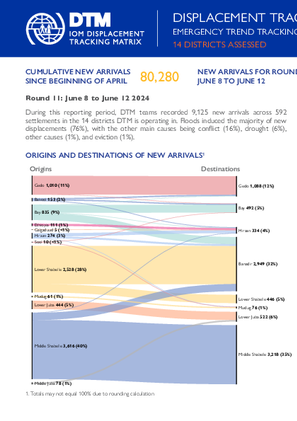
Contact
DTM Somalia, IOMSomaliaDTM@iom.int
Language
English
Location
Somalia
Period Covered
Jun 08 2024
Jun 12 2024
Activity
- Mobility Tracking
- Baseline Assessment
This latest round of Emergency Trends Tracking was initiated in April 2024 to monitor displacements movements during the Gu rainy season. Districts covered in this round include Afgooye, Afmadow, Baardheere, Baidoa, Balcad, Belet Weyne, Dayniile, Gaalkacyo, Hodan, Jamaame, Jowhar, Kahda, Kismaayo, Luuq. ETT is a crisis-based tool that tracks sudden displacement triggered by specific events or emerging crises.
The objective of ETT is to help prioritize humanitarian response and to enable partners to deliver rapid assistance. Based on previous shock induced displacement patterns, the humanitarian community expects that people will continue to move toward urban areas in search of humanitarian services. Consequently, the ETT coverage focuses on the main urban centers and surrounding villages for each assessed district. The data is collected through Key Informant Interviews (KIIs) at the location level, from Sunday to Wednesday every week. It includes information on new arrivals, numbers and demographic of IDPs, reasons for displacement, intentions, humanitarian assistance and priority needs among others.
The ETT tool also adapts to regional contexts: because of the very high number of IDP sites in Khada and Daynile districts in Banadir region and in Baidoa district in Bay region, a zonal approach has been adopted for these areas. Each week, KIIs are first conducted at the zone level to indicate to the field teams which locations have received the most new arrivals and which need to be assessed. To facilitate the joint analysis of the CCCM (Camp Coordination and Camp Management) Cluster’s New Arrivals Tracker (NAT) and ETT data, the assistance and needs indicators are identical in both tools.
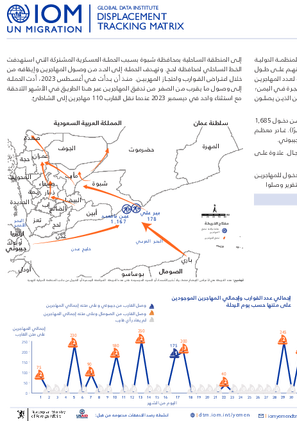
Contact
DTM Yemen, DTMYemen@iom.int
Language
English
Location
Yemen
Period Covered
May 01 2024
May 31 2024
Activity
- Flow Monitoring
في مايو 2024، أبلغت مصفوفة تتبع النزوح في اليمن التابعة للمنظمة الدولية للهجرة عن دخول 1,685 مهاجرًا إلى اليمن، بزيادة قدرها 14 بالمائة عن الرقم الإجمالي المُبلغ عنه في الشهر السابق (1,479 مهاجرًا). غادر معظم المهاجرين (90%) من منطقة باري في الصومال (1,510)، في حين غادر العشرة في المائة المتبقية من أوبوك، جيبوتي.
ومن بين إجمالي المهاجرين المسجلين، كان 13 في المائة أطفال، و26 في المائة نساء، و62 في المائة رجال). علاوة على ذلك، ذكر 80 في المائة من المهاجرين أن النزاع كان السبب الرئيسي الذي دفعهم إلى مغادرة بلدهم الأصلي.
وعادةً ما تكون لحج بمثابة نقطة دخول للمهاجرين المغادرين عبر جيبوتي، في حين تعد شبوة بمثابة نقطة دخول للمهاجرين المغادرين عبر الصومال. ومع ذلك، فإن جميع المهاجرين الذين غادروا جيبوتي والصومال في الفترة المشمولة بالتقرير وصلوا إلى المنطقة الساحلية بمحافظة شبوة بسبب الحملة العسكرية المشتركة التي استهدفت الخط الساحلي لمحافظة لحج. وتهدف الحملة إلى الحد من وصول المهاجرين وإيقافه من خلال اعتراض القوارب واحتجاز المهربين. منذ أن بدأت في أغسطس 2023، أدت الحملة إلى وصول ما يقرب من الصفر من تدفق المهاجرين عبر هذا الطريق في الأشهر اللاحقة مع استثناء واحد في ديسمبر 2023 عندما نقل القارب 110 مهاجرين إلى الشاطئ.
حدد فريق مصفوفة تتبع النزوح 4,010 عائدًا يمنيًا في مايو 2024، وهو ما يمثل انخفاضًا بنسبة 21 بالمائة مقارنة بعدد العائدين في أبريل (5,046 فردًا). بالإضافة إلى ذلك، سجل الفريق ما مجموعه 221 مهاجرًا تم ترحيلهم من عمان إلى نقطة ديفن في مديرية شحن بمحافظة المهرة باليمن. وكان جميع المهاجرين المرحلين من عمان مواطنين إثيوبيين.
أجبرت الأزمة الإنسانية المتفاقمة في اليمن العديد من المهاجرين على اتخاذ قرار صعب بالعودة إلى بلدانهم الأصلية في القرن الأفريقي، حيث أفادت التقارير أن السلطات قامت بترحيل بعضهم. في مايو 2024، سجلت مصفوفة تتبع النزوح ما مجموعه 750 مهاجرًا غادروا اليمن إما طوعًا أو تم ترحيلهم بالقوارب من اليمن. وتتكون هذه المجموعة من 90% رجال، و9% نساء، و1% أطفال.
علاوة على ذلك، في مايو 2024، أبلغ فريق مصفوفة تتبع النزوح في جيبوتي عن وصول إجمالي 1,240 مهاجرًا (91% رجال، و8% نساء، و1% أطفال) إلى جيبوتي قادمين من اليمن بعد القيام برحلة محفوفة بالمخاطر للعودة إلى وطنهم. وتؤكد هذه الأرقام التحديات الكبيرة التي يواجهها المهاجرون في اليمن والظروف اليائسة التي دفعتهم إلى المخاطرة برحلات بحرية خطيرة.
Contact
iomyemendtm@iom.int
Location
Yemen
Activity
- Flow Monitoring
Period Covered
May 01 2024 -May 31 2024
In May 2024, the IOM Yemen DTM reported 1,685 migrants entering Yemen, a 14 per cent increase from the total figure reported in the previous month (1,479 migrants). Most migrants (90%) left from Bari Region in Somalia (1,510), while the remaining ten per cent left from Obock, Djibouti.
Among the total migrants recorded, 13 per cent were children, 26 per cent were women, and 62 per cent were men). Furthermore, 80 per cent of migrants stated that conflict was the primary reason encourage them for leaving their country of origin.
Typically, Lahj serves as an entry point for migrants departing through Djibouti whereas Shabwah serves as an entry point for migrants departing through Somalia. However, all migrants departed from Djibouti and Somalia in this reporting period arrived in coastal area of Shabwah Governorate due joint military campaign targeting the coastline of Lahj Governorate. The campaign aiming at reducing and stopping the arrival of migrants by intercepting boats and detaining smugglers. Since it started in August 2023, the campaign resulted a near-zero arrival of migrant flow through this route in the subsequent months with a single exception in December 2023 when boat transported 110 migrants ashore.
The DTM team identified 4,010 Yemeni returnees in May 2024, a 21 per cent decrease compared to the number of returnees in April (5,046 individuals). Additionally, the team recorded a total of 221 migrants that were deported from Oman back to Deifen Point in Shahan district of Al Maharah governorate, Yemen. All deported migrants from Oman were Ethiopian nationals.
The worsening humanitarian crisis in Yemen has compelled many migrants to make difficult decision to return to their home countries in the Horn of Africa, some have reportedly been deported by authorities. In May 2024, the DTM recorded a total of 750 migrants leaving Yemen either voluntarily or were deported by boat from Yemen. This group was composed of 90 per cent men, nine per cent women, and one per cent children.
Furthermore, in May 2024, the Djibouti DTM team reported a total of 1,240 migrants (91% men, 8% women, and 1% children) arrived in Djibouti from Yemen after undertaking a perilous journey back home. These figures underscore the significant challenges migrants in Yemen face and the desperate circumstances that have led them to risk dangerous sea voyages.
Population Groups
Migrants Present
Survey Methodology
Unit of Analysis Or Observation
Admin Area 2
Individual
Type of Survey or Assessment
Key Informant
Keywords
Geographical Scope Partial Coverage
Administrative boundaries with available data
The current dataset covers the following administrative boundaries
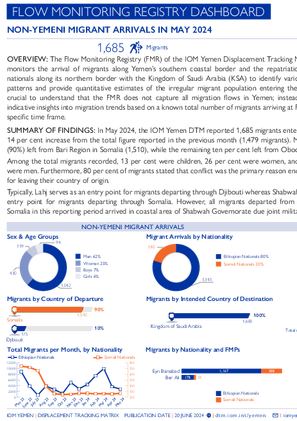
Contact
DTM Yemen, DTMYemen@iom.int
Language
English
Location
Yemen
Period Covered
May 01 2024
May 31 2024
Activity
- Flow Monitoring
OVERVIEW: The Flow Monitoring Registry (FMR) of the IOM Yemen Displacement Tracking Matrix (DTM) monitors the arrival of migrants along Yemen’s southern coastal border and the repatriation of Yemeni nationals along its northern border with the Kingdom of Saudi Arabia (KSA) to identify various migration patterns and provide quantitative estimates of the irregular migrant population entering the country. It’s crucial to understand that the FMR does not capture all migration flows in Yemen; instead, it provides indicative insights into migration trends based on a known total number of migrants arriving at FMPs during a specific time frame.
SUMMARY OF FINDINGS: In May 2024, the IOM Yemen DTM reported 1,685 migrants entering Yemen, a 14 per cent increase from the total figure reported in the previous month (1,479 migrants). Most migrants (90%) left from Bari Region in Somalia (1,510), while the remaining ten per cent left from Obock, Djibouti.
Among the total migrants recorded, 13 per cent were children, 26 per cent were women, and 62 per cent were men). Furthermore, 80 per cent of migrants stated that conflict was the primary reason encourage them for leaving their country of origin.
Typically, Lahj serves as an entry point for migrants departing through Djibouti whereas Shabwah serves as an entry point for migrants departing through Somalia. However, all migrants departed from Djibouti and Somalia in this reporting period arrived in coastal area of Shabwah Governorate due joint military campaign targeting the coastline of Lahj Governorate. The campaign aiming at reducing and stopping the arrival of migrants by intercepting boats and detaining smugglers. Since it started in August 2023, the campaign resulted a near-zero arrival of migrant flow through this route in the subsequent months with a single exception in December 2023 when boat transported 110 migrants ashore.
The DTM team identified 4,010 Yemeni returnees in May 2024, a 21 per cent decrease compared to the number of returnees in April (5,046 individuals). Additionally, the team recorded a total of 221 migrants that were deported from Oman back to Deifen Point in Shahan district of Al Maharah governorate, Yemen. All deported migrants from Oman were Ethiopian nationals.
The worsening humanitarian crisis in Yemen has compelled many migrants to make difficult decision to return to their home countries in the Horn of Africa, some have reportedly been deported by authorities. In May 2024, the DTM recorded a total of 750 migrants leaving Yemen either voluntarily or were deported by boat from Yemen. This group was composed of 90 per cent men, nine per cent women, and one per cent children.
Furthermore, in May 2024, the Djibouti DTM team reported a total of 1,240 migrants (91% men, 8% women, and 1% children) arrived in Djibouti from Yemen after undertaking a perilous journey back home. These figures underscore the significant challenges migrants in Yemen face and the desperate circumstances that have led them to risk dangerous sea voyages.
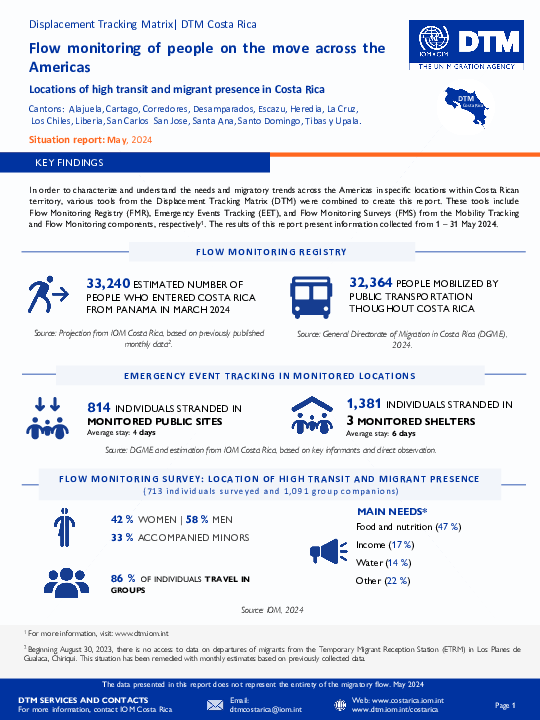
Contact
DTMCostaRica@iom.int
Language
English
Location
Costa Rica
Period Covered
May 01 2024
May 31 2024
Activity
- Survey
- Registration
- Flow Monitoring
- Mobility Tracking
Cantons: Alajuela, Alajuela, Cartago, Corredores, Desamparados, Escazu, Heredia, La Cruz, Los Chiles, Liberia, San Carlos San Jose, Santa Ana, Santo Domingo, Tibas y Upala
Costa Rica, like other Central American countries, has been characterized as a migratory corridor for the flow of people in mobility through the Americas. This flow is mainly composed of people from the Bolivarian Republic of Venezuela, Cuba, Haiti, Ecuador, as well as from other countries in South America, Africa, and Asia. According to estimates from IOM Costa Rica, during May 2024, approximately 33,240 people entered the country, with a daily average of 1,072 people. This represents a 7% increase compared to April 2024. Additionally, 814 people were identified as stranded in monitored public places and 1,381 people stranded in monitored shelters.
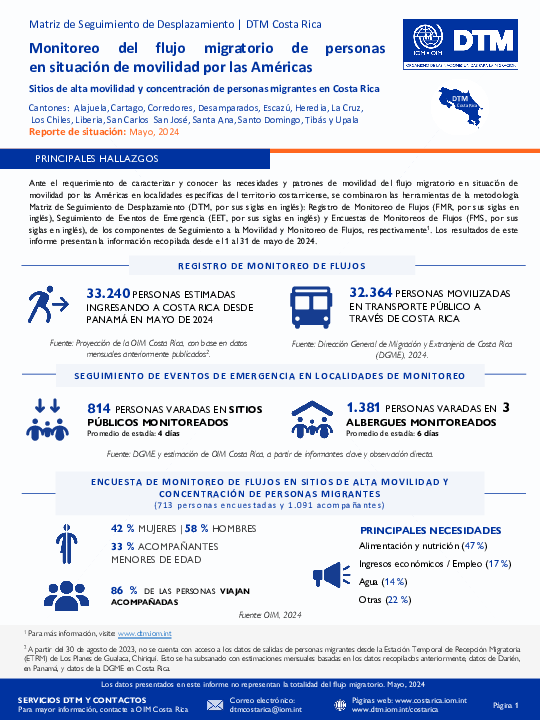
Contact
Angélica Madrigal amadrigal@iom.int
Language
English
Location
Costa Rica
Period Covered
May 01 2024
May 31 2024
Activity
- Survey
- Registration
- Flow Monitoring
Cantons: Alajuela, Alajuelita, Cartago, Desamparados, Escazú, Corredores, Heredia, Los Chiles, San Carlos, San José, Santa Ana, Santo Domingo, Tibás
Costa Rica, al igual que otros países de América Central, se ha distinguido por ser un corredor migratorio del flujo en situación de movilidad por las Américas. Este flujo está compuesto principalmente por personas provenientes de la República Bolivariana de Venezuela, Cuba, Haití, Ecuador, así como de otros países de Suramérica, África y Asia. Según estimaciones de la OIM Costa Rica, durante mayo de 2024 ingresaron al país aproximadamente 33.240 personas, con un promedio diario de 1.072 personas. Esto representa un aumento del 7% en comparación con abril de 2024. Además, se identificaron 814 personas varadas en los sitios públicos monitoreados y 1.381 personas varadas en los albergues monitoreados.
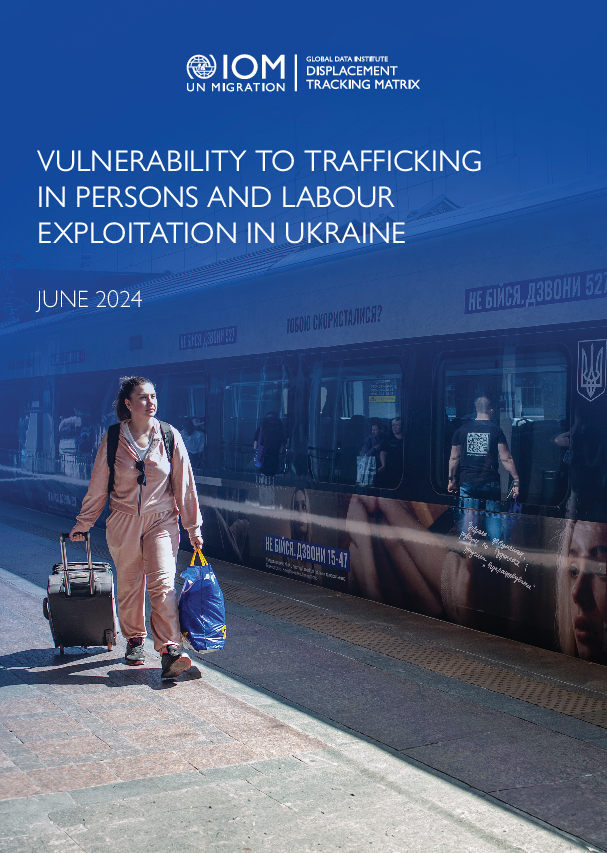
Contact
DTM Ukraine, dtmukraine@iom.int
Language
English
Location
Ukraine
Period Covered
Mar 10 2024
Apr 11 2024
Activity
- Other
The full-scale invasion of Ukraine by the Russian Federation in February 2022 has triggered mass displacement and a humanitarian crisis, heightening the population’s vulnerability to protection risks, including trafficking in persons, particularly among displaced and conflict-affected communities. Despite comprehensive responses aimed at mitigating an expected surge in trafficking, significant risks persist as coping strategies are increasingly strained. Anti-trafficking actors across Ukraine have been vocal about the risks of trafficking, based on pre-existing trafficking trends within the country and region, knowledge of trafficking in emergencies from previous crises, and the specificities of this crisis.
This report examines protection risks related to the war in Ukraine, focusing on labour exploitation, travel-related deception, and the awareness and accessibility of support systems. Utilizing data from the IOM General Population Survey, the report aims to support evidence-based programming, policy-making, advocacy, and further research.

Contact
DTM Europe, DTMMediterranean@iom.int
Language
English
Location
North Macedonia
Period Covered
Aug 06 2023
Mar 08 2024
Activity
- Survey
- Flow Monitoring Survey
- Flow Monitoring
This report presents the results of the fourth round of the Displacement Tracking Matrix (DTM) Flow Monitoring Surveys (FMS) implemented in North Macedonia. The data was collected from 26 June to 31 August 2023, in three flow monitoring points. IOM interviewed a total of 183 individual respondents.
FMS provide a snapshot of the profiles, experiences and needs of migrants transiting through North Macedonia. The survey asks questions on demographics, education and employment backgrounds, the circumstances of the migration journey and migration factors, as well as future intentions.

Contact
IOMASTANA@iom.int
Language
English
Location
Kazakhstan
Period Covered
Jan 01 2024
Mar 31 2024
Activity
- Survey
- Flow Monitoring
- Mobility Tracking
- Baseline Assessment
The quarterly report is developed by combining secondary data obtained from different sources, including government agencies, international organizations, non-profit entities, and other types of organizations. More specifically, the report for the first quarter of 2024 was derived from data from the Ministry of Internal Affairs, Bureau of National Statistics, and Border Service of Kazakhstan. The data was compiled through a combination of published sources and direct requests to the partners and government agencies.

Contact
DTMUkraine@iom.int
Language
English
Location
Ukraine
Period Covered
Mar 10 2024
Apr 11 2024
Activity
- Survey
Between 10 March and 11 April 2024, the International Organization for Migration (IOM) conducted Round 16 of the General Population Survey (GPS), a highly representative assessment of internal displacement in Ukraine. The data presented in this report was commissioned by the International Organization for Migration (IOM) and collected by 59 enumerators employed by Multicultural Insights through screener phone-based interviews with 20,000 randomly selected respondents and follow-up interviews with 1,428 IDPs, 1,639 returnees, and 2,266 residents, using the computer-assisted telephone interview (CATI) method, and a random digit dial (RDD) approach.
This report provides the main findings from Round 16 of the GPS, including detailed insights into population figures, mobility intentions, demographic profiles, household composition and vulnerabilities, and needs of the returnee population, to facilitate evidence-based decision-making on strategic, technical, and programmatic aspects of the response and recovery efforts in Ukraine.
